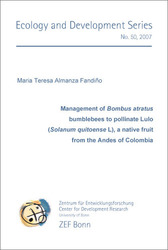| Departments | |
|---|---|
| Book Series (96) |
1378
|
| Nachhaltigkeit |
3
|
| Gesundheitswesen |
1
|
| Humanities |
2364
|
| Natural Sciences |
5406
|
| Mathematics | 229 |
| Informatics | 319 |
| Physics | 980 |
| Chemistry | 1363 |
| Geosciences | 131 |
| Human medicine | 243 |
| Stomatology | 10 |
| Veterinary medicine | 108 |
| Pharmacy | 147 |
| Biology | 835 |
| Biochemistry, molecular biology, gene technology | 121 |
| Biophysics | 25 |
| Domestic and nutritional science | 45 |
| Agricultural science | 1004 |
| Forest science | 201 |
| Horticultural science | 20 |
| Environmental research, ecology and landscape conservation | 148 |
| Engineering |
1793
|
| Common |
98
|
|
Leitlinien Unfallchirurgie
5. Auflage bestellen |
|
Advanced Search
Management of Bombus atratus bumblebees to pollinate Lulo (Solanum quitoense L), a native fruit from the Andes of Colombia (English shop)
Maria Teresa Almanza (Author)Preview
Table of Contents, Datei (41 KB)
Extract, Datei (450 KB)
Solanum quitoense (Lulo) from the northern Andes is a fruit with an attractive taste. It has a high export potential but its production is hampered by insufficient pollination. Studies on the reproductive system of Lulo revealed that, due to their poricidal anthers, the flowers need pollinators for self- and cross-pollination. Pollination by native bumblebees significantly increases fruit set and quality. Experiments show that colonies of Bombus atratus can be reared in captivity and used in Lulo fields for providing increased pollination services. Modeling based on data on colony development reveal larva/workers ratio and the supply of pollen as main parameters for improving the rearing method.
| ISBN-13 (Printausgabe) | 3867271879 |
| ISBN-13 (Hard Copy) | 9783867271875 |
| ISBN-13 (eBook) | 9783736921870 |
| Final Book Format | A5 |
| Language | English |
| Page Number | 132 |
| Lamination of Cover | glossy |
| Edition | 1 |
| Book Series | ZEF Bonn |
| Volume | 0 |
| Publication Place | Göttingen |
| Place of Dissertation | Bonn |
| Publication Date | 2007-03-13 |
| General Categorization | Dissertation |
| Departments |
Agricultural science
|








